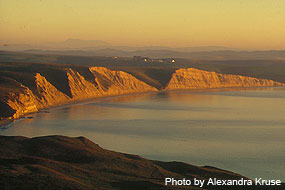|
You are viewing ARCHIVED content published online before January 20, 2025.
Please note that this content is NOT UPDATED, and links may not work. For current information,
visit https://www.nps.gov/aboutus/news/index.htm.
Contact: Jessica Luo, 415-464-5132

Earlier this month, California's Fish and Game Commission approved a sweeping plan to protect ocean habitats in 24 marine protected areas (MPAs) in state and federal waters, in accordance with the Marine Life Protection Act, a state law passed in 1999. The north central coast study region, the second area in California where MPAs have been created, includes over 200 miles of central California coast and encompasses waters within Point Reyes National Seashore and Golden Gate National Recreation Area. Off the coast of Point Reyes National Seashore, there will be five MPAs and three "no disturbance" special closures for marine bird and mammals colonies. These MPAs include two fully protected no-take marine reserves, two marine conservation areas where some take is allowed, and one marine park. NPS currently has jurisdiction out to a quarter-mile off the coast of park lands. These newly created MPAs will cover waters up to three miles off the coast. The Fish and Game Commission adopted a plan that was developed during two years of public discussion, scientific study and participation by various parties with an interest in ocean protection. The National Park Service has been involved with this process by attending public meetings, helping draft proposed MPAs, serving on the scientific advisory team, conducting education and outreach initiatives, and by providing funding for three years of MPA monitoring. The network of MPAs:
In the waters adjacent to Point Reyes National Seashore (see Map, 207 KB PDF), the following MPAs were created:
There is a global body of scientific evidence about the effectiveness of marine reserves in restoring marine ecosystems. Many marine scientists, conservationists, fishermen, divers and surfers hope that these MPAs in California’s oceans will help restore our declining fisheries and ensure the continuation of these natural resources for generations to come. The adopted network of MPAs is this region of California is scheduled to go into effect in February 2010. Continued monitoring, enforcement and education are essential for the success of these MPAs. For more information, view our "What are Marine Protected Areas?" poster (510 KB PDF), read our Marine Life Protection Act newsletter (545 KLB PDF) or contact Jessica Luo at 415-464-5132 or by email. -NPS- |
Last updated: August 28, 2021
